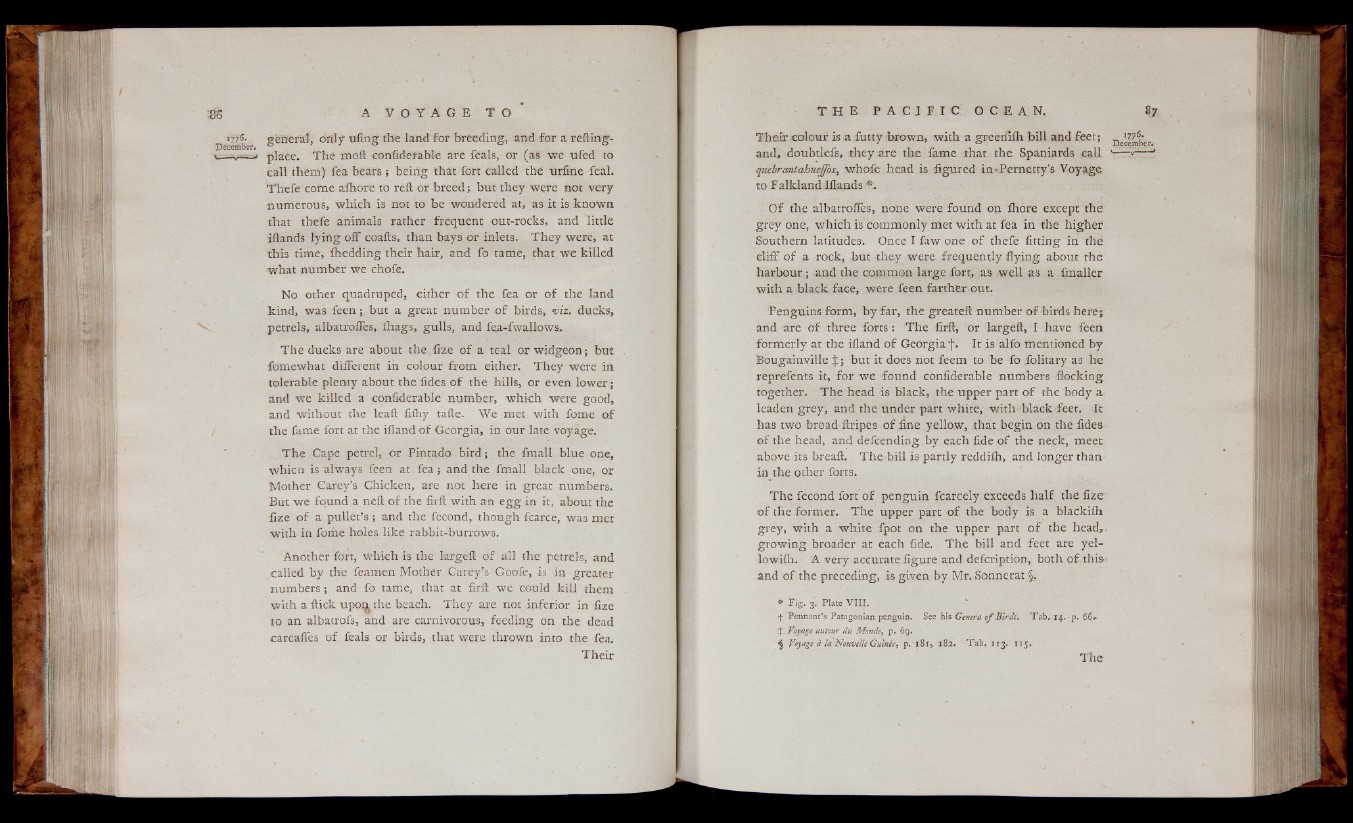
general, ortly ufing the land for breeding, and for a refting-
place. Thè moil confiderable are feals, or (as we ufed to
call them) fea bears ; being that fort called the urline feal.
Thefe come alhore to reft or breed ; but they were not very
numerous, which is not to be wondered at, as it is known
that thefe animals rather frequent out-rocks, and little
illands lying ofF coafts, than bays or inlets. They were, at
this time, fhedding their hair, and fo tame, that we killed
what number we chofe.
No other quadruped, either of the fea or of the land
kind, was feen ; but a great number of birds, viz. ducks,
petrels, albatrolfes, ihags, gulls, and fea-fwallows.
The ducks are about the lize of a teal or widgeon; but
fomewhat different in colour from either. They were in
tolerable plenty about the lides of the hills, or even lower ;
and we killed a confiderable number, which were good,
and without the leaft fiihy tafte. We met with fome of
the fame fort at the illand o f Georgia, in our late voyage.
The Cape petrel, or Pintado bird ; the fmall blue one,
whicn is always feen at fea ; and the fmall black one, or
Mother Carey’s Chicken, are not here in great numbers.
But we found a neft of the firft with an egg in it, about the
fize of a pullet’s ; and the fecond, though fcarce, was met
with in fome holes like rabbit-burrows.
Another fort, Which is the largeft of all the petrels, and
called by the feamen Mother Carey’s Goòfe, is in greater
numbers ; and fo tame, that at firft we could kill them
with a flick upon the beach. They are not inferior in fize
to an albatrofs, and are carnivorous, feeding on the dead
carcalTes of feals or birds, that were thrown into the fea.
Their
Their colour is a futty brown, with a greëniih bill and feet; DeJ.7-7fib‘er
and, doubtlefs, they are the fame „that the Spaniards call '— >---- ’
quebrantahuejfos, whofe head is figured in-Pernetty’s Voyage
to Falkland Blands '*.
Of the albatrofles, none were found on ihore except the
grey one, which is commonly met with at fea in the higher
Southern latitudes. Once I faw one. o f thefe fitting in the
cliff of a rock, but they were frequently-flying about the
harbour ; and the common large fort, as well as a fmaller
with a black face, were feen farther out.
Penguins form, by far, the greateft number o f birds here;
and are of three forts : The firft, or largeft, I have feen
formerly at the illand of Georgia f . It is alfo mentioned by
Bougainville f ; but it does not feem to be fo Xolitary as he
reprefents it, for we found confiderable numbers flocking
together. The head is black, the upper part of the body a
leaden grey, and the under part white, with- black feet. It
has two broad ftripes of fine yellow, that begin on the fides
of the head, and defcending by each fide of the neck, meet
above.its breaft. The bill is partly reddiih, and longer than
in the other forts.
The fecond fort of penguin fcarcely exceeds half the fize
of the former. The upper part of the body is a blackilh
grey, with a white fpot on the upper part of the head,,
growing broader at each fide. The bill and feet are yel-
lowilh. A very accurate figure and defcription, both of this,
and of the preceding, is given by Mr. Sonnerat §,
* Fig. 3. Plate V I II .
f Pennant’s Patagonian penguin. See his Genera o f Birds. Tab.-14. -p. 66-.
X^Voyage autour du Monde, p. 69.
§ Voyage à la Nouvelle Guinée^ p. i8 r5 182. Tab. 113. 115»
The